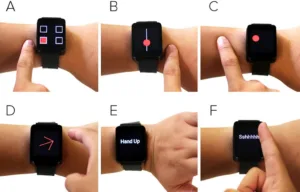The current generation of smartwatches use the front surface of the device for two related functions: display and touch input. This approach has two consequences. First, the input device (think finger), will occasionally but inevitably block the user’s view of the display. The second is that the “real estate” available for touch input is necessarily confined to a physically small area.

A team headed by Junhan Zhou in the department of Electrical & Computer Engineering at Carnegie Mellon University (Pittsburgh, PA) is developing a novel means to address this issue. Called AuraSense, the new technique is based on electric field sensing and extends the region for input into a volume around the smartwatch (or other device).
A recent article on AuraSense was presented at the User Interface Software and Technology conference held between October 16th and 19th in Tokyo, Japan. A copy of this article is available on-line and can be found here.
In this article, the team points out that the concept of using electric field sensing for input is not new. The AuraSense research is, however, claimed to be the first report of an investigation into the use of the technology in a smartwatch application.
The article discussed the team’s investigation into several different antenna configurations. It is reported that, of the candidate antenna configurations, the so-called shunt-mode type offered the most satisfactory signals and was the most physically compatible with a watch form factor. The shunt-mode configuration uses emitting and receiving electrode pairs and measures the disturbance when a conductive object (again, think finger) interferes with the electric field. In the AuraSense approach, shunt-mode is implemented using one transmitter and four receiver electrodes. Copper foil tape is used for the electrodes and these are covered by a thin layer of insulating Mylar tape.
Several prototypes were built. In each case, the transmitter was configured to generate an electric field by emitting a 115 kHz, 3Vpp square wave. A chip monitored each of the receiver electrodes and computed the field attenuation at 200 frames per second. The data was transmitted to a laptop over USB for further processing.
One determination made from studying the prototype devices was that no single shunt-mode antenna configuration was able to support all of the types of input desired for AuraSense. In response to this situation, the team designed a prototype with ten electrodes that could be dynamically switched between different antenna configurations. By this means, it was found possible to enable high quality sensing for each of the six types of input that were desired.
Several of the inputs studied were touchscreen-like finger tracking on the skin. These included buttons on the skin, sliders on the skin, a trackpad on the skin and radial input. Each of these inputs is illustrated in the figure below.
These types of input are also illustrated in a video that can be found at the end of this article.
Hand gestures were also studied as a means of input. This included movements of the hand on the same arm as the smartwatch as well as gestural input by the other hand in the volume above the face of the smartwatch.
Based on these studies, the team concluded that AuraSense “can be robust across both users and environments.”
The team further concluded that electric field sensing is well suited for “around device interaction” for these additional reasons:
- It is fast (~200 frames per second)
- Low-cost (~$5)
- Requires no additional instrumentation on the arm or finger
- Does not suffer from line-of-sight issues (that is, it works through clothing).
In their article, the team also identified several areas that need improvement before electric field sensing is fully ready for use in a product. The most significant limitation was signal drift. To mitigate this issue, the team suggests that it may be possible to “use an adaptive baseline, or perhaps machine learning features based on relative values between electrodes, rather than absolute values.” In addition, electric field sensing was found susceptible to ambient electrical noise.
The team suggests that “adaptive background subtraction” might help mitigate this issue. Finally, the team noted that the physically small size of a smartwatch limits the size of the electrodes as well as the maximum distance between transmitter and receiver pairs. This physical size constraint limits the range over which a finger can be sensed to a few centimeters and, thus, restricts inputs to a volume near the device.
Current smartwatch touchscreens have real limitations. The electric field sensing approach to addressing these issues has some appeal and has shown initial promise. If the remaining issues can be successfully addressed, then the technology may have commercial potential. – Arthur Berman
Carnegie Mellon University, Junhan Zhou, [email protected]

